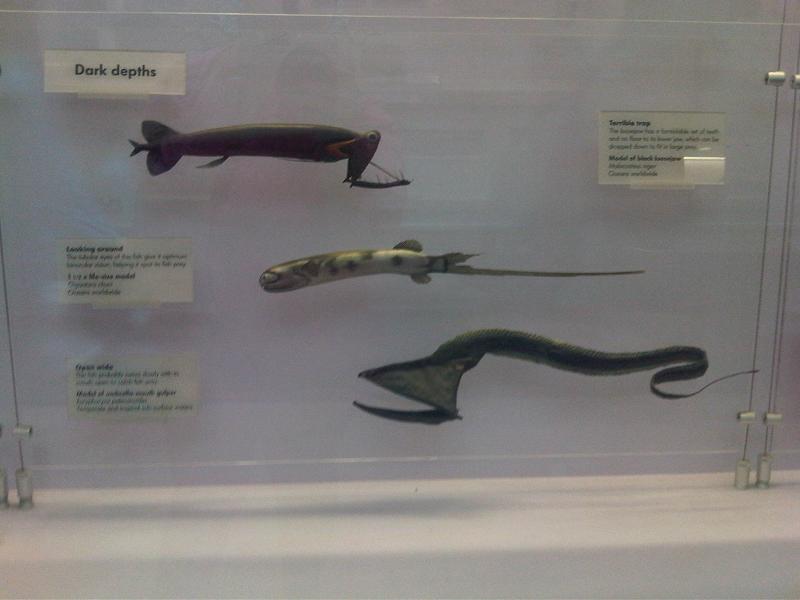Swallows food, much of it larger than them, whole
Advertisement
Telescope Fish Scientific Classification
Read our Complete Guide to Classification of Animals.
Telescope Fish Conservation Status
Telescope Fish Facts
- Prey
- Plankton
- Group Behavior
- Solitary/School
- Fun Fact
- Swallows food, much of it larger than them, whole
- Estimated Population Size
- Unknown
- Biggest Threat
- Carnivorous fish life
- Most Distinctive Feature
- Protruding eyes
- Other Name(s)
- Common trumpeters, real bastard trumpeters
- Habitat
- Deep sea depths of world oceans
- Predators
- Shark and other large fish
- Diet
- Omnivore
- Favorite Food
- Other fish life, particularly plankton
- Common Name
- telescope fish
- Number Of Species
- 2
View all of the Telescope Fish images!
The telescope fish is a striking, colorful creature that exists in deep-sea tropical and subtropical ecosystems. The telescope fish exists in depths of three-quarter miles to 1.3 miles down.
Living deep below surfaces and away from natural light, these fish live in dark waters. To compensate, Mother Nature gave the telescope fish tubular eyes that jut from the skull like a pair of binoculars. The feature lets the fish see and find prey in the most mesopelagic twilight zones.
The fish uses their unique eyes to find food. They swim, directing the eyes up toward surfaces. This allows them to spot silhouettes of their prey. It’s believed the fish move vertically in the water column to see both prey and predator.
The telescope fish is also called common trumpeters and real bastard trumpeters.
5 Incredible Telescope Fish Facts!
Read on to learn some amazing facts about the telescope fish.
- Telescope fish have an extendable mouth and jaw, a great tool for snatching up prey quickly.
- Because of their existence pretty much beyond man’s reach, little information is actually known about the distribution, lifespan, appearance, diet, etc. of the telescope fish.
- Synchronized swimming is the norm for this species.
- Communication is a combo of gestures, vibrations, motions and body language.
- Unlike a lot of ocean life, there are no names to differentiate the fish sexes.
Telescope Fish Classification and Scientific Name
The telescope fish is a deep-sea aulopiform of fish, comprising the species Gigantura chuni. There are only two species. Outside of that, little information is really known about the critters.
The genus name (Gigantura) is derived from Gigantes, a legendary group of giants in Greek mythology. That’s matched with the oura suffix, which means “end” or “tail.” So, Giantura is a reference to the ribbon-ish, elongated lower tailfin that comprises half the fish’s total length.
Types of Telescope Fish
While little is actually known about the telescope fish, we do know there are two distinct species.
Gigantura chuni
Gigantura chuni, commonly known as the telescope fish, is a deep-sea animal found in waters of the Indian, Atlantic, and Pacific oceans. It also calls home the Gulf of Mexico. Additionally, there have been occasional sightings in South Africa.
The telescope fish has also been sighted in the waters of New Zealand, Chile, Saint Paul, Tasmania, Gough Island, and Amsterdam.
Gigantura indica
The Gigantura indica is a predatory deep-sea animal with a silvery, scaleless body. Like its cousin, Gigantura chuni, the creature has those fascinating tubular, forward-directed eyes with large lenses and a ribbon-like tail. The eyes allow them to see silhouettes of prey swimming above them in the waters.
Both species are naturally used to a specific environment deep in the waters. This is why experts don’t consider the species suitable for captivity. The telescope fish is better in temperate oceans which cannot be easily adapted to tanks. Or rather the cost of creating and regulating an environment for the telescope fish, plus the expense of the animal itself, is pretty cost-prohibitive.
Other Types of Telescope Fish
The telescope fish genus is unique, but some species bear a striking resemblance to them. These include:
- Heavenly fish
- Lion‘s head
- Bubbly eyes
- Demekin
- Kite fish
- Dragon eye
The Demekin has the greatest resemblance to the telescope fish. What distinguishes the Demekin from the telescope fish is the fin color and shape (which is more like a butterfly) and a larger tail.
Telescope Fish Appearance
These animals have protruding eyes with small glass shields. The bubble lenses consist of around two dozen dorsal spines. From the right angle, they also look like binoculars or more specifically a pair of telescopes.
The fish have large heads and a greenish-blue color with a silvery underside. They have blue dotting and small brown lines that form stripes along the sides and back. The fish have tough, slimy scales and a sharp snout. The tail makes up almost half the body.
There is actually little known about the amphibians. Tracking them is difficult and capturing them isn’t practical as duplicating their ecosystems would be a chore in any manmade environment. They can grow up to 16 inches in length.

©By Emőke Dénes – kindly granted by the author, CC BY-SA 4.0, https://commons.wikimedia.org/w/index.php?curid=16151233 – License
Telescope Fish Distribution, Population, and Habitat
The telescope fish lives in the marine oceans of Tasmania, southern Chile, New Zealand, Amsterdam, Saint Paul, and Gough Island.
The population, though not closely monitored, is considered healthy and of “Least Concern” by conservationist groups. In several cases, the fish are not evaluated at all, such as at the IUCN. There’s not enough information about the numbers to generate reliable data.
The fish has a habitat range across sub-Antarctic bodies of temperate cool waters. The telescope scope is located in depths of over 66 feet within the water columns and up to 2,000 miles below surfaces. They’re also found in surge channels and large low tidal pools.
While relatively solitary by nature, the telescope fish tends to travel in groups. You’ll never find a single telescope fish by itself. The groupings make for easier hunts. It’s also a good way for the animals to watch everyone’s six for predators.
Telescope Fish vs. Telescope Goldfish
The telescope goldfish is an exotic fish and not to be confused with the telescope fish. In fact, they have nothing in common except protruding opticals. But while the telescope fish’s eyes jut forward, the goldfish version has eyes that pop out on the sides.
The length of the protrusion can vary, but the eyestalks can extend almost three-quarters of an inch. Juvenile goldfish are born with normal-sized eyes. The telescoping effect doesn’t begin until the fish begins to mature.
Like any other goldfish, this creature is a domesticated pet found in many household tanks.
Telescope Fish Predators and Prey
Like every single critter crawling on this planet, the telescope fish — as much a predator as anything — has its enemies and its preferred diet. Let’s take a look at both.
Predators: What Eats the Telescope Fish?
Telescope fish will grow up to six inches in length. That makes them relatively small fish in a big pond called the ocean. So, telescope fish are the prey of large carnivore fish and sharks that inhabit these environments.
Prey: What Does the Telescope Fish Eat?
Relative solitary predators, this species can’t wait to get its jaws on bristlemouths, lanternfish, and barbed dragonfish. They also go after plankton.
The telescope fish swallows its prey whole. That includes sea creatures that are often larger than the telescope fish. But this ability to eat in such a manner is common for creatures at those depths.
The telescope fish has an extendable mouth with sharp teeth. They quickly snatch prey, usually from below as the telescope fish is constantly looking up for food.
Telescope Fish Reproduction and Lifespan
There is little to say about their reproduction process. But we know all fish species lay eggs during their unique breeding season. The telescope fish is no different. They lay eggs and wait for hatching.
Fish eggs are attached to plants. Otherwise, little else is known about the gestation period, the species’ sexual behavior, or the number of eggs they lay.
The lifespan of the telescope fish is estimated between six and 25 years. It’s a strangely odd lifespan but we take into account that studies of the species aren’t extensive.
Telescope Fish in Fishing and Cooking
Considering their habitat, these are not fish easily available for capture. So, it’s not likely you’ll find the telescope fish on anyone’s menu.
View all 133 animals that start with TTelescope Fish FAQs (Frequently Asked Questions)
Where Are Telescope Fish Found?
The telescope fish lives in tropical and subtropical waters. They can survive in depths of up to 1¼ miles below water surfaces.
How Big is a Telescope Fish?
Typical lengths for the telescope fish are between two and four inches. But the telescope fish is capable of growing up to half a foot long. There is at least one record of a specimen getting to 16 inches.
What Does the Telescope Fish Look Like?
The fish comes with a greenish-blue body highlighted by silvery shades on the underside. They have up to two dozen dorsal spines, three anal spines, and up to 21 soft dorsal rays. Plus, there are those soft, glassy, protruding eyes.
Does the Telescope Fish Make for a Good Pet?
You might be mistaking this species for the Telescope Goldfish, definitely a common house pet. The telescope fish would be a costly investment even if you found a captive version.
Thank you for reading! Have some feedback for us? Contact the AZ Animals editorial team.
Sources
- Kidadl, Available here: https://kidadl.com/animal-facts/telescope-fish-facts
- Ocean, Available here: https://ocean.si.edu/telescope-fish
- Aquariadise, Available here: https://www.aquariadise.com/telescope-goldfish/#:~:text=Juvenile%20telescope%20goldfish%20are%20generally,can%20join%20the%20adult%20tank.
- Fish List, Available here: https://fishlists.com/telescope-goldfish/
- Oregon State University, Available here: https://fwcs.oregonstate.edu/150-species/telescopefish

















